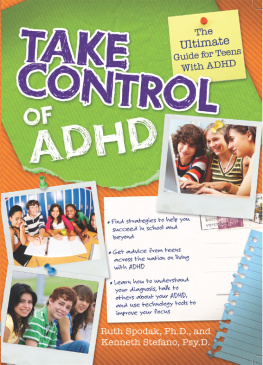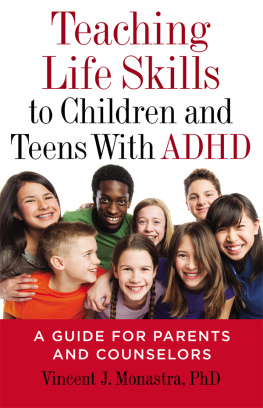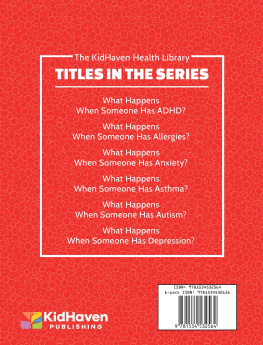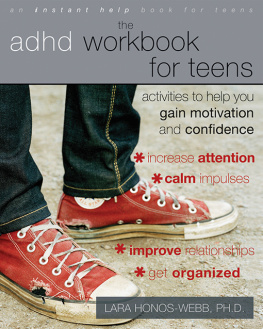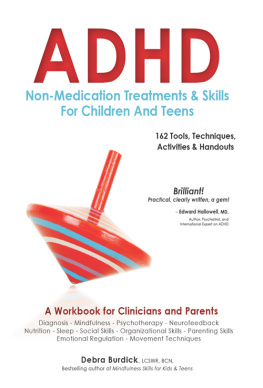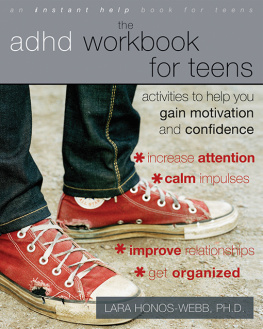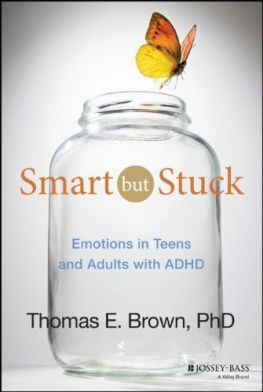Copyright 2011, Prufrock Press Inc.
Edited by Lacy Compton
Cover and Layout Design by Marjorie Parker
ISBN-13: 978-1-59363-537-4
No part of this book may be reproduced, translated, stored in a retrieval system, or transmitted, in any form or by any means, electronic, mechanical, photocopying, microfilming, recording, or otherwise, without written permission from the publisher.
At the time of this books publication, all facts and figures cited are the most current available. All telephone numbers, addresses, and website URLs are accurate and active. All publications, organizations, websites, and other resources exist as described in the book, and all have been verified. The authors and Prufrock Press Inc. make no warranty or guarantee concerning the information and materials given out by organizations or content found at websites, and we are not responsible for any changes that occur after this books publication. If you find an error, please contact Prufrock Press Inc.
 |
Prufrock Press Inc. P.O. Box 8813 Waco, TX 76714-8813 Phone: (800) 998-2208 Fax: (800) 240-0333 http://www.prufrock.com |
TAKE
CONTROL OF
ADHD

DEDICATION
To my sons, Doug and Jeff, and their wonderful wives and childrencontinued sources of love and joy.
Ruth B. Spodak
To Mike and all of the other boys and girls with ADHD who have worked with me over the years. Your stories have touched me and your successes have inspired me. You are the reason that I do what I do.
Kenneth Stefano
ACKNOWLEDGMENTS
T here are many people we would like to acknowledge for their help and support with this project. Dr. Larry Silver, one of the major authorities in the field of Attention Deficit/Hyperactivity Disorders and learning disabilities, has been a source of inspiration and support throughout our professional careers. We are grateful that he continues to be someone we can turn to for advice with complex diagnoses. We also want to thank Rich Weinfeld who, by example and encouragement, started us on the track of writing this book.
We thank our editor, Lacy Compton, who has answered our multiple questions and been a source of support as we worked through this process.
On a daily basis, Margaret Ascienzo, who technically is our Office Manager/Intake Coordinator, but is really the glue that holds our office together, provides us with the support and structure we need to be effective. A very special and heartfelt thanks for her enthusiasm, her warm and welcoming attitude to parents and students, and for always being there for us and the rest of our staff. We dont know how you carved out all those blocks of time for us to work on this book, but we really appreciate it.
We are grateful to our friends and colleagues who have read this book and provided us valuable feedback and suggestions.
A special thank you to all of the students with ADHD who let us interview them for this book. Your stories and quotes were honest, insightful, and oftentimes humorous. A very special acknowledgment and thank you to all of the students with ADHD we have worked with over many years. Your confidence in us, your hard work, and the successes you have experienced have provided us with the inspiration to continue in this rewarding profession.
FOREWORD
I have read many books on ADHD that were written for adolescents. Each has useful information. Each educates the reader. It was with this expectation that I read Take Control of ADHD: The Ultimate Guide for Teens With ADHD. I quickly realized that this book was different.
If I were a teen reading this book, I would feel like I was sitting in a room with two caring individuals who understood me, knew my struggles, and wanted to help. Id feel as though the authors were looking directly at me and speaking directly to me. Ruth Spodak and Ken Stefano have succeeded in using a style of communication that is both informative and personal. The reader senses that the authors understand and that they want to help. The authors provide useful and practical information. They then use this information to empower teens to take control of their lives and to take action.
The first four chapters provide the information needed for the teen to understand who he or she is as an adolescent with ADHD. gives a realistic view of how long ADHD might last.
Chapters 5 through 8 discuss what the teen can do. He must join with his parents and school professionals to work on the consequences of having ADHD. The information provided empowers the teen to take ownership and to take charge of his or her life. discusses four different areas where teens with ADHD can advocate for and help themselves overcome their attention problems.
Finally, in , the authors put it all together for the teen reader. The information in the book is blended and integrated into a plan for action.
Thank you, Ruth and Ken, for taking the effort to write this book. It will not only inform teens with ADHD, it will empower them with the necessary knowledge and sense of self that will help them truly take control of their ADHD.
Larry B. Silver, M.D.,
Clinical Professor of Psychiatry,
Georgetown University Medical Center
INTRODUCTION
JAKES STORY
Jake was always getting in trouble. He didnt mean to act up; he just couldnt stop himself from moving and talking all of the time. It was like Jake had a motor inside of him that was always revving at high speed. In fact, his parents used to call him Motor Man because of the way he would run around the house with his toy cars and planes. And when he got an idea about something, Jake just could not stop himself from acting on it, such as the time when he was 6 years old and wanted to see how many LEGO bricks he could flush down the toilet. He wasnt trying to clog the toilet and flood the bathroombut thats exactly what happened. His parents were really not happy with him that day.
When they werent upset with him, his parents liked to tell stories of how they had to Jake proof the house when Jake was younger. For example, they put locks on all of the kitchen cabinets to keep 4-year-old Jake from getting into everything. They also talked about what a poor sleeper he was and how they used to end up with bruises from Jake kicking them in his sleep when he would climb into his parents bed at night. Jake didnt like these stories because they made him feel like he was a loser. Even though his parents often told him that they loved him, he was still always getting in trouble. The two most frequent phrases he heard from his parentsand teacherswere stop doing that and settle down. Jake was tired of being scolded all of the time.
Things werent much better in school either. In fact, now that hes in ninth grade, things are worse than ever. Jake has a hard time paying attention and never seems to get his class work finished. Truth is, hes bored most of the time in class, especially when his teachers are presenting new information and Jake is supposed to be taking notes. He tries to listen, but before too long his mind starts drifting, and he ends up thinking about his upcoming baseball game or what he is going to do next weekend. When he isnt daydreaming in class, Jake is talking to his friends. It is bad enough that he gets in trouble for talking, but sometimes he gets his friends in trouble too. For example, his best friend, Mike, asked to have his seat changed in English class so that he could move away from Jake. In fact, many of Jakes friends are getting frustrated with him. He has lost count of the number of times his friends tell him to chill because he is talking too much or interrupting them when they are talking. Last week the whole baseball team got upset with him because he missed an easy fly ball when he was daydreaming instead of paying attention to the game.

